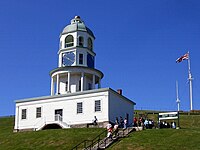Local Council of Women of Halifax
| Part of a series on the | ||||
| History of Nova Scotia | ||||
|---|---|---|---|---|
 | ||||
| Events | ||||
|
||||
| Other | ||||
|
||||
The Local Council of Women of Halifax (LCWH) is an organization in
Historical Context
In 1851 women were excluded from the vote in Nova Scotia. In 1870,
Suffrage

The year following the defeat of the first suffrage bill, the Local Council was established in 1894 as the local chapter of the
In June 1897 the annual meeting of the National Council was convened in Halifax, where presentations were made by Lady Aberdeen and American suffragist May Wright Sewall.[10]
On June 11, 1914, the Suffrage Club was established at Wright's home to work on granting women the right to vote throughout the province. On 22 February 1917 the LCWH presented a suffrage petition endorsed by forty-one women's organizations. When the Liberal Premier ignored the issue, irate members introduced a private member bill. Its defeat marked the birth of the Nova Scotia Equal Franchise League in the spring of 1917.[12]
On April 26, 1918, with the support of premier
Other contributions
The members of the LCWH (the Nova Scotia 5) established the following organizations:
- Victoria School of Art and Design (NSCAD)
- Art Gallery of Nova Scotia
- Nova Scotia Red Cross
- Children's Hospital, Halifax (IWK)
- Dalhousie Alumnae Association
- Forrest Hall, Dalhousie's first residence for women
- Halifax Victorian Order of Nurses
- Dalhousie Review
- Ladies Musical Club of Halifax
- Halifax Playground Commission
- Pioneer Book Club
- Shakespeare Club
- Official Employment Bureau
- School of Domestic Science
- Women's Welcome Hostel
- Anti-Tuberlculosis League
| History of Halifax, Nova Scotia |
|---|
 |
Nova Scotia 5
-
Anna Leonowens - made famous in musical The King and I
-
May Sexton
Other members
-
Laura Borden - wife of Prime minister Robert Borden
See also
Links
References
Endnotes
- ^ Ian McKay. The 1910s: The Stillborn Triumph of Progressive Reform. In The Atlantic Provinces in Confederation edited by E. R. Forbes, Delphin Andrew Muise, University of Toronto. 1993. p. 202
- ^ Canadian Biography
- ^ Robertson, Allen B. (1998). "Norris, Hannah Maria". In Cook, Ramsay; Hamelin, Jean (eds.). Dictionary of Canadian Biography. Vol. XIV (1911–1920) (online ed.). University of Toronto Press.
- ^ article, p. 6
- ^ Ruth Bordin. Woman and Temperance: The Quest for Power and Liberty, 1873-1900. Philadelphia: Temple University Press, 1981.
- ^ Cahill, Barry; Girard, Philip (2005). "Longley, James Wilberforce". In Cook, Ramsay; Bélanger, Réal (eds.). Dictionary of Canadian Biography. Vol. XV (1921–1930) (online ed.). University of Toronto Press.
- ^ Timeline of Women's History, Canada
- ^ Sandra Markham, Leisure and the National Council of Women of Canada, 1995
- ^ "Biography – BEST, EDNA MAY WILLISTON (Sexton) – Volume XV (1921-1930) – Dictionary of Canadian Biography".
- ^ a b Yorke, Lois K. (1998). "Edwards, Anna Harriette". In Cook, Ramsay; Hamelin, Jean (eds.). Dictionary of Canadian Biography. Vol. XIV (1911–1920) (online ed.). University of Toronto Press.
- ^ Women's Suffrage Movement in Canada by Patricia Roome, p. 6
- ^ Women's Suffrage Movement in Canada by Patricia Roome, p. 14
- ^ Premier Murray's response
- ^ "Archived copy" (PDF). Archived from the original (PDF) on 2017-09-22. Retrieved 2017-11-27.
{{cite web}}: CS1 maint: archived copy as title (link)
Further reading
- Joanne E. Veer, "Feminist Forebears: The Woman's Christian Temperance Union in Canada's Maritime Provinces, 1875-1900" (PhD thesis, University of New Brunswick, 1994), 5.
- Ruth Bordin, Woman and Temperance: The Quest for Power and Liberty, 1873-1900 (Philadelphia: Temple University Press, 1981)
- Ernest R. Forbes, "Battles in Another War: Edith Archibald and the Halifax Feminist Movement" in Challenging the Regional Stereotype: Essays on the 20th Century Maritimes (Fredericton: Acadiensis Press, 1989)
- Ernest R. Forbes, "The ideas of Carol Bacchi and the Suffragists of Halifax" in Challenging the Regional Stereotype: Essays on the 20th Century Maritimes (Fredericton: Acadiensis Press, 1989)
- Ernest R. Forbes. Prohibition and the Social Gospel in Nova Scotia. 1971.
- Mothers of the Municipality: Women, Work and Social Policy in Post-1945 Halifax edited by Judith Fingard, Janet Guildford
- Judith Fingard. The Ritchie Sisters and Social Improvement in Early 20th Century Halifax. Journal of the Royal Nova Scotia Historical Society, Vol. 13, 2010. 1-22







![Margaret Marshall Saunders - author of Beautiful Joe[14]](http://upload.wikimedia.org/wikipedia/commons/thumb/d/d8/Margaret_Marshall_Saunders_001.jpg/76px-Margaret_Marshall_Saunders_001.jpg)